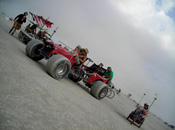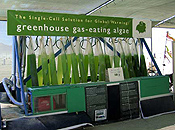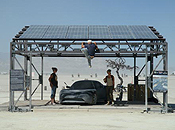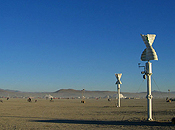In 2007 our art theme expressed the immanence of nature in our lives in a variety of ways. The Burning Man stood atop a structure that resembled green mountain peaks. Nestled at its base was the Green Man Pavilion, 30,000 square feet of shaded exhibition space for the display of interactive artistic, scientific and educational models, a “World’s Fair” of emerging technologies. This pavilion was surrounded by the Mangrove, made from simulated trees fashioned from recycled industrial materials. These artificial trees were not burned: they survive to subdivide the blue of other skies.
Click the name of an Art Installation in the list below to see details about it.
Exhibits
- Bicycle Lifestyle
- Burning Question for Humanity
- Carbon Footprint
- Clean Death
- Consious Carnival
- EcoCity Visions
- Electric Sportscar
- Energy Is For Everyone
- Energy Is Water In A Desert World
- F.I.R.E. (Future Impact Reduction Education) Center
- Leaning Tower of Power
- Making the Choice
- Mechabolic Demo
- Off the Grid Shelter & Rocket Stoves
- OYA
- Pedal Power
- Permaculture Playground
- Playatech Open Source Lounge
- Pump’N’Go Transportation Transformation Information Station
- Ship Kites
- Single Cell Solution Exhaust-Capturing Algae Farm
- Solar Carport
- Solar Race Car
- Solar Water Bar
- Steam Powered Garden Tractor
- Veg Car
- Wind Turbine Twins
- Wind Turbine Demo
- Wind Turbine
- Zen Garden Soundscape
Bicycle Lifestyle
by Kipchoge Spencer & Paul Freedman
The world has car trouble. It’s simultaneously beset with the imminent, immense threat of climate change, an ever-growing population striving to own more of the same automobiles that cause it, wars raging to control the cars’ fuel supply, cities choked by gridlock and bad air, sprawling auto-centric suburbs that isolate us from our would-be communities, and streets so religiously dedicated to motor vehicles that alternatives are perceived as unsafe if not insane; meanwhile the 5 billion people who can’t afford a car often have no viable means of participating in a transport-centric economy. And the brightest hope we’re offered are hybrid autos that feed the same sprawl, cause the same congestion, use nearly as much of the same fuel on the same roads, and cost more.
Burning Question for Humanity
by Jacqui Lindsay & Ian Manheimer
If we’re going to find to the right answers to today’s pressing problems, we need to start by asking the right questions. These images and questions, posed by people all over the world, begin to explore concerns about the human footprint — questions about energy, ecology, and sustainable ways of life. By sharing these questions, we hope to encourage people to continue to ask questions they most want the world to address, and to engage in dialogue, knowledge exchange, and action to generate new ideas and solutions for the most pressing issues facing our planet.
Carbon Footprint
by Jack Haye, David Shearer and Tom Price
This piece explores the scope of the climate change problem of a one-ton carbon footprint. A closer look by the viewer reveals solutions to the problems associated with carbon pollution.
 Clean Death
Clean Death
by Cynthia Beale
A collage of images and words on cardboard cremation containers conveys the current industrial management of death, its emerging biodegradable and traditional alternatives, and the laws of natural return that all matter on Earth is subject to. A handmade coffin from recycled newspaper and a paper fiber urn mounted on the two halves of the Dark Green Man offer a glimpse of the possibilities on this side of the human compost pile. We have the choice to gift our bodies back to the soilweb that made us. As we step into our next journey, the world that we once were – the creature that danced on leaves and flew in planes, stared at stars and dreamed of god – can take its next turn through another life, join the forest tribe, store carbon, breathe out oxygen, and grow to be a tree.
Consious Carnival, featuring Dr. FeelFine’s Cure-All Circus Sideshow & the Puppet Party
by Jonathan Youtt
In this interactive exhibit, we feature artistically presented informational kiosks presenting information about simple tips to guide people to change their daily practices to embrace a less wasteful and polluting existence. Subjects include Sustainable Home, Body, Agriculture, Transportation, and Development. Come see the funhouse showcasing various oddities and GMO freaks like a broccoli bird and CornDog, all under the Old Time Circus Banner!
EcoCity Visions
by Tawni Aaron
In this unprecedented era of global climate change and societal unrest, there is an urgent need for design solutions to implement large-scale sustainable urban projects. How can we engineer the cities of the future to be more sustainable? Come see the shape of things that might come.
Electric Sportscar
by Aaron Platshon
Electric Vehicles: Not Just a Longer Tailpipe. The electric car, once the “zero-emissions” darling of environmentalists, is sometimes maligned as an “emissions-elsewhere” vehicle, since the electricity to charge its batteries must be generated in electrical generation plants that produce emissions. This is a reasonable point, but we must then ask how much pollution an electric car produces per mile – accounting for all emissions, starting from the gas or oil well where the source fuel is extracted, all the way to the final consumption of electricity by the car’s motor. When we work through the numbers, we find that the electric car is significantly more efficient and pollutes less than all alternatives
Energy Is For Everyone
by Rahul Sharma
Our goal is to allow participants at Burning Man to have first-hand experience with the power of kinetic energy as it relates to illumination and radio technology, to show how ‘built to last’ technology can truly be re-deployed in both developed and developing world markets, to demonstrate through pictures how this technology is enabling a ‘greener’ developing world, and to evoke a sense of responsibility amongst participants to re-think their own energy consumption and requirements at future Burning Man events-and do it all in less than 2 minutes!
Energy Is Water In A Desert World
by Russell Wilcox
What is energy, how does it flow, how is it stored? Three large interactive panels will explore these in turn. One illustrates three different forms of energy that do the same work to show they are equivalent. Another display is a Rube Goldberg arrangement of different ways to convert one type of energy into another. And finally the third is mainly about electricity, understanding it’s nature, and role in our daily lives.
F.I.R.E. (Future Impact Reduction Education) Center
by John Stayton
The purpose of the Future Impact Reduction Education (FIRE) Nexus: Information Technology in Service to Nature is twofold.
1) to raise awareness of the ecological impacts of individual behavior as well as humanity’s collective impact on Earth’s vital systems.
2) to inspire individuals to change personal behavior to reduce their impact, as well as to inspire action to advance solutions to regional and global issues.
Methodology includes Interactive Survey Terminals and the Reduction Theater. This installation is produced by students, alumni, faculty and friends of the Green MBA at Dominican University.
Leaning Tower of Power
by Doron Amiran
Americans purchase nearly three billion dry-cell batteries every year to power radios, toys, cellular phones, watches, laptop computers, and portable power tools. This display explores humans’ battery usage and the solutions to the high cost of disposable batteries to our environment.
Making the Choice
by Mia Hanak & Andrew Ãœtt
How does our use of cell phones in Black Rock City contribute to the disappearance of endangered mountain gorilla habitat in the Democratic Republic of the Congo? Join us for an exhibit that explores how our daily habits affect the global environment, and learn how you can take personal action locally in being part of the solution worldwide. In this exhibit, art serves as the catalyst to stimulate dialogue about seven topics including Waste Reduction, Water, Environmental Health, Transportation, Urban Design, Urban Nature, and Energy.
Mechabolic Demo
by Jim Mason
Scale model of that monster slug on the open playa.
Off the Grid Shelter & Rocket Stoves
by Ray Cirino
Building your shelter and keeping it warm doesn’t mean you need to use a lot of resources-in fact, you can use nothing but junk! When combined with rocket stoves (which heat and boil water and light space with just a few sticks and without green house gases) you can have a comfortable, low impact lifestyle.
OYA
by Ryan Wartena & Evonne Heynin
Part science, part magic, all love; using water and flow to generate electricity, OYA is an application of a core philosophy where energy can only be created with intention, and the intention here is to raise the awareness of the goddess OYA by growing and crystallizing a form. The playa is made of lake evaporites, which include gypsum, which is calcium sulfate dihydrate. When dried, it becomes anhydrite or plaster of Paris, and when rewetted, under the right conditions, can become the crystal selenite. Use of the energy, both by participant and electricity, will grow a form composed of playa, the latest in the growing architecture experiments.
Pedal Power
by City of San Francisco and Exploratorium
Sit down and get cranking.
Permaculture Playground
by Starhawk
Permaculture is ecological design that works with nature’s patterns to create living and growing systems that meet human needs while regenerating the natural and social environment around them. The Permaculture Playground Is a sacred space, an encapsulated permaculture design course and a ritual journey that showcases sustainable solutions. The labyrinthine path through this structure made of recycled materials passes through the Hallway of Destruction (and avoiding the Cul-de-Sac of False Solutions) offers a chance to compost grief about the destruction of the earth. Participants continue through the Circle of Ancestral Wisdom, the Mandala of the Elements and the Gallery of Patterns into the Playpen filled with design games. Images of inspirational projects and solutions lead to the exit Gate of Commitment-how do we take this all home?
 Playatech Open Source Lounge
Playatech Open Source Lounge
by Arthur Zwern
A large workshop space and lounge created from 100% renewable/sustainable wood assembles without a single metal fastener, and collapses to ship in one fuel-saving mini-van load. Furniture is the platform we use to accomplish work, play, and rest – this platform is open source and DIY, which eliminates most of the furniture industry’s environmental footprint and turns everyone who builds it into an industrial artist. Designed to support green learning in a green context, the Playatech Open Source Lounge is a playa gift from a pretend company pioneering a business model based on the ten Burning Man Principles – and it completely recycles into fuel, not landfill fodder.
 Pump’N’Go Transportation Transformation Information Station
Pump’N’Go Transportation Transformation Information Station
by Shaye Harty
Inside the skeleton of a repurposed relic plucked from petroleum purgatory (in other words, a retired and gutted out gasoline pump), viewers can watch footage of all-terrain human powered vehicles in action — over land, sand, mud, and water. A schedule reveals how to meet with the engineers of these crazy contraptions and how to try out the technology. A fuel-less future can be achieved using the perfection of pedal power.
Ship Kites
by Dave Culp and Dean Jordan
Bringing the art and science of sailing back to cargo ships can reduce fuel costs and all emissions by 20% or more with zero effect on scheduling, speed or industry infrastructure. Kites on ships, as opposed to masted sails, are perhaps the most efficient and least expensive alternate energy application in existence for the power they produce.
 Single Cell Solution Exhaust-Capturing Algae Farm
Single Cell Solution Exhaust-Capturing Algae Farm
by the Chlorophyll Collective
Algae, one of the earth’s oldest organisms, can provide mankind with radically up-to-date global solutions by:
- Producing enough energy to eliminate US dependence on foreign oil.
- Preventing the depletion of natural resources.
- Eliminating additions to greenhouse gases which cause global warming.
- Simplifying mankind’s energy supply through sustainable closed-loop energy systems.
Using our CO2 waste to fuel the natural oxygen-giving processes of algae, the Chlorophyll Collective is creating a natural global cooling method for future participants of Burning Man to eliminate carbon emissions while demonstrating the ultimate collaboration with one of the oldest organisms on earth
 Solar Carport
Solar Carport
by Emma Adelson
Part of a residential solution to the renewable energy dilemma, a kit-built canopy (typically described as a carport but useful as habitual space as well) makes solar energy more accessible and available to individuals worldwide-and makes cool, comfortable shade at the same time.
Solar Race Car
by Bruce Rogow
The year was 1997. The challenge: build a car running on nothing but solar power, and race it across America. This is Suntrakker II, representing the technological path from racing to showroom. Solar cars like this one paved the way for many of the design innovations that are common place today, and demonstrate what is capable when we put our minds to achieving the impossible
Solar Water Bar
by Greg Hanson & Darlene MacHutta
Portable and stationary, solar-powered water treatment systems use fine filtration and ultraviolet light disinfection for remote locations around the world, where water purification and electrical power are impractical or unattainable. They have provided women and children of developing nations with clean drinking water since 1991. When natural disasters strike, drinking water can become quickly contaminated or unavailable. By using these systems, most contaminated or polluted water sources can be converted to cleaner and safer drinking water for disaster relief.
Steam Powered Garden Tractor
by Tom Kimmel
This looks like a garden tractor with a smoke stack on top of the boiler. Home-made in a small machine shop, it is powered by wood (bio-fuel). It’s an ideal vehicle for anyone without access to refined petroleum.
Veg Car
by David Shelhart and William Hibbits
Our Veg Car installation will educate participants about a diesel vehicle fuel alternative (waste vegetable oil) that exists and is readily available. The Veg Car will demonstrate to participants that the technology to allow diesel motors to run on veg is easy to understand and can be readily differentiated from the stock motor when looking at a converted car. We hope to empower participants to take interest in reducing their vehicular carbon emissions, and demonstrate that running a diesel vehicle on veg is a viable alternative to fossil fuels.
 Wind Turbine Twins
Wind Turbine Twins
by Michael Slattery
By capturing the power of the wind from any direction, clean, renewable energy is created by the Wind Turbine. Its blade is made up of 18 identical segments that form an organic structure reminiscent of a seashell or twirling Sufi dancer. Light bounces off the shining white surface as it turns in a silent hypnotic spiral. Its mate, standing nearby, reflects its move in time with the wind.
Wind Turbine Demo
by Rob Barrosa
Efficient little wind turbines generate renewable energy within city limits and in an aesthetically pleasing way. The 6.5 foot tall turbines, which can be lined up side by side, are ideal for flat-roofed buildings. All they require is a 7-mph startup wind to produce 55 kWh a month per unit.
Wind Turbine
by Miriam Roberts
Want to power a small house, without a big footprint? This 1.8KW wind turbine generates 400 kilowatt hours per month, enough for a small family’s needs, by taking advantage of large, quiet blades, and a low cut in speed.
Zen Garden Soundscape
by TradeMark G
Tucked away in the Marin Headlands, just north of San Francisco, lies a Nike Missile Site. There sit the remnants of the US Army Nike Ajax and Hercules missiles, neutered of their warheads and fuel. They have come to this Zen Garden as tools of destruction recycled into musical instruments, the sounds of pounding those swords of destruction into plowshares captured on tape.
They join here the aural landscape of water and thunderstorms (representing the dried lake bed on which Burning Man takes place), the calls of animals (representing the natural world beyond the playa), and the wind that flows between them, a meditation on the nature of “natural” sounds.

